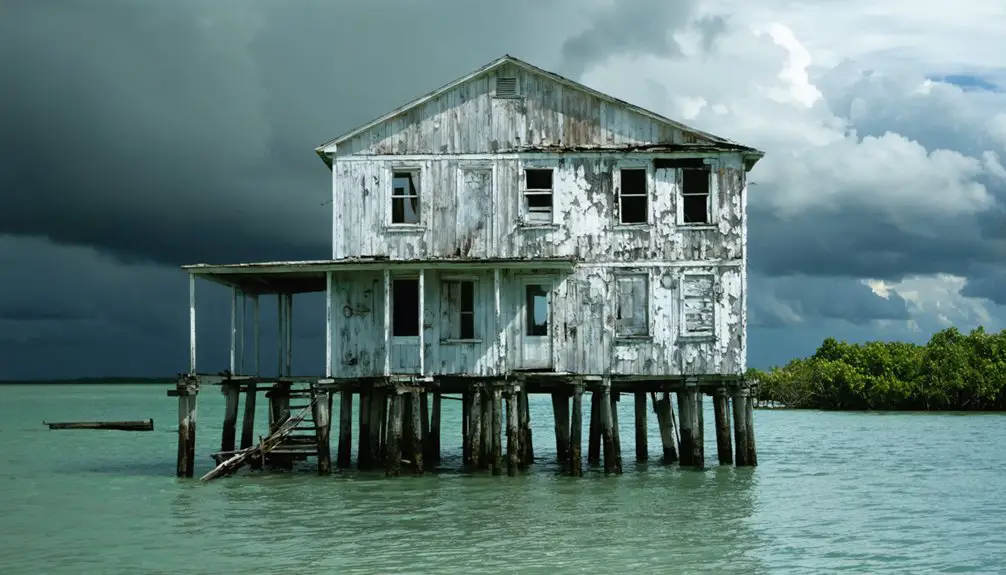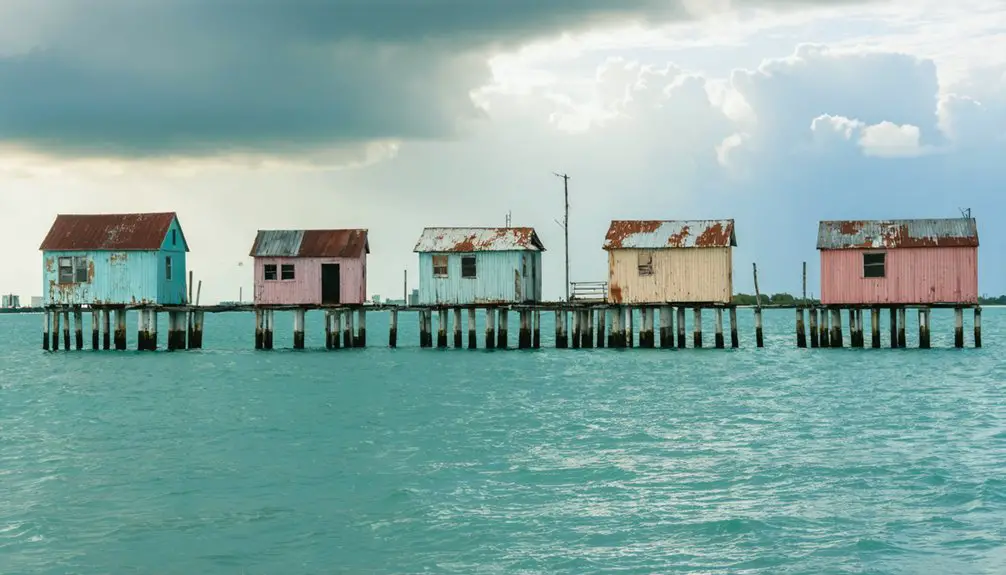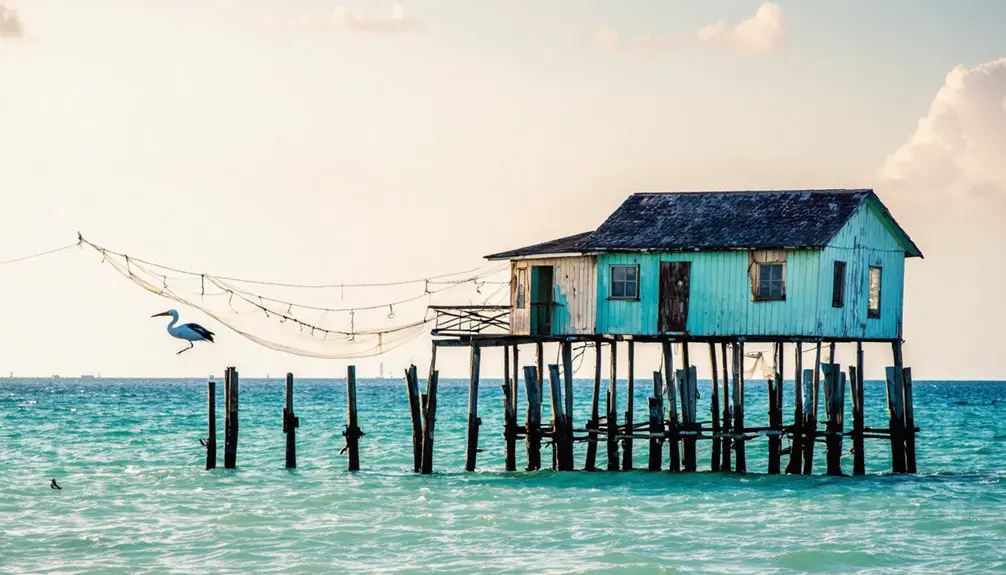You’ll discover Stiltsville’s remarkable history in Miami’s Biscayne Bay, where seven wooden houses still stand on stilts above turquoise waters. Founded in the 1930s by “Crawfish” Eddie Walker, this once-thriving community of 27 structures served as a playground for the elite, featuring exclusive clubs and infamous parties. Though hurricanes and legal battles have taken their toll, these resilient structures continue to captivate visitors, preserving tales of South Florida’s bold maritime spirit.
Key Takeaways
- Stiltsville consists of seven remaining wooden houses built on stilts above Biscayne Bay, down from its peak of 27 structures.
- The community declined after Hurricane Andrew in 1992, transforming from a vibrant social hub into a protected historical site.
- Located one mile offshore from Miami, these abandoned structures represent the remnants of a once-thriving party destination.
- Originally established in the 1930s as bait shops and social clubs, the structures now stand as preserved relics within Biscayne National Park.
- Access is limited and strictly controlled by the Stiltsville Trust, making the site appear more ghost town-like than its lively past.
The Birth of Miami’s Mysterious Water Village
When Eddie “Crawfish” Walker built the first notable shack above Biscayne Bay’s shallow waters in the early 1930s, he unknowingly laid the foundation for one of Florida’s most enigmatic communities.
You’ll find Stiltsville‘s fishing traditions deeply rooted in the resourceful spirit of local fishermen who sought refuge from Miami’s bustling streets.
Walker’s shack, where he sold bait, beer, and his famous crawfish stew, became the catalyst for a unique architectural evolution. The community grew rapidly after channel dredging created more shallow areas suitable for construction. Soon, wooden huts on stilts and converted barges dotted the seascape, creating an off-grid haven known simply as “The Shacks.”
Despite his blindness, Walker’s intimate knowledge of the bay’s shallow waters and weather patterns helped transform these humble fishing outposts into a thriving community, where the Miami Beach Rod & Reel Club would gather at the nearby Calvert Club. During the Prohibition era, his establishment gained notoriety as a gambling house where visitors could try their luck away from watchful eyes.
From Crawfish Eddie to Social Hotspot
You’ll find Stiltsville’s origins in “Crawfish” Eddie Walker’s pioneering 1933 bait shop, where he served his famous *chilau* chowder and provided a haven for those seeking entertainment beyond Miami’s shoreline restrictions.
Within years, Eddie’s humble shack inspired friends to build their own elevated homes, transforming the shallow waters into a growing community of resourceful pioneers who initially used grounded barges before adopting proper stilts.
The area’s character shifted dramatically when the Calvert Club opened in the late 1930s, ushering in an era of exclusive social clubs that would make Stiltsville a magnet for Miami’s elite through the mid-20th century. At its height, the vibrant community grew to include twenty-seven wooden structures dotting the azure waters of Biscayne Bay. The legendary Quarterdeck Club became particularly famous after being featured in Life magazine in 1941.
Humble Origins Above Water
The fascinating origins of Stiltsville trace back to the early 1930s, when “Crawfish” Eddie Walker established the first known structure above Biscayne Bay’s shallow waters.
His legacy sparked a unique fishing culture that would shape Miami’s maritime history, starting with a simple bait shop that doubled as a gambling spot just beyond law enforcement’s reach. The area rapidly expanded as twenty-seven structures populated the waters before Hurricane Donna struck.
- Picture wooden shacks perched precariously on barges and boats intentionally run aground
- Imagine the aroma of Eddie’s famous crawfish chowder wafting across the water
- Envision small boats tied up alongside, their occupants fishing beneath the stilted structures
Socialites and Secret Clubs
From humble beginnings as Crawfish Eddie’s rustic bait shack, Stiltsville transformed into Miami’s most exclusive offshore playground during the late 1930s and early 1940s.
You’d find the city’s elite flocking to social clubs like the pioneering Calvert Club and the infamous Quarterdeck Club, where gambling and exotic dancers entertained hundreds at a time.
The party scene reached new heights in 1962 with the Bikini Club, housed in a converted yacht where dollar memberships bought you access to nude sunbathing and free drinks for bikini-clad women.
Politicians, celebrities, and socialites sought refuge here from prying eyes, living by the motto “what happens in Stiltsville stays in Stiltsville.” At its peak, the vibrant community boasted twenty-seven wooden structures dotting the crystalline waters of Biscayne Bay.
Though police raids and hurricanes eventually shuttered these elite gatherings, they cemented Stiltsville’s legacy as Miami’s most intriguing escape. Hurricane Betsy in 1965 led to stricter building codes that effectively ended the era of commercial entertainment venues.
Life Above the Bay: Architecture and Design
You’ll discover that building on Biscayne Bay’s shallow waters required remarkable ingenuity, as fishermen transformed wooden shacks on stilts into increasingly sophisticated structures.
These buildings had to withstand fierce natural challenges, from daily tidal flows to devastating hurricanes, while serving both practical and social purposes.
Whether constructed on repurposed barges or elevated on wooden pilings driven into the seabed, each structure represented a careful balance between architectural ambition and environmental adaptation.
Building on Water’s Edge
Rising gracefully above Biscayne Bay’s shallow flats, Stiltsville’s unique architectural legacy began in the 1930s with humble wooden shacks that evolved into more sophisticated waterfront dwellings.
You’ll find a remarkable example of architectural innovation in these structures, where builders adapted to the challenges of marine construction by using lightweight materials and creative foundation solutions.
The essence of waterfront living shines through in these distinctive buildings:
- Wooden pilings driven into seagrass flats support elevated structures that dance above the high tide
- Wrap-around porches and expansive decks maximize views while creating natural gathering spaces
- A-frame designs and Mansard roofs blend coastal functionality with mid-century style
You’re witnessing a perfect marriage of necessity and ingenuity, where each building reflects both the practical demands of marine life and the freedom of coastal living.
Surviving Nature’s Fierce Tests
While the architectural design of Stiltsville’s homes showcases remarkable ingenuity, nature has repeatedly tested their resilience through fierce hurricanes, relentless salt corrosion, and punishing storms.
You’ll find these elevated structures weren’t built by chance – their architectural resilience stems from carefully planned features. The wooden stilts allow storm surges to pass underneath, while wrap-around porches provide essential shelter and ventilation.
Their lightweight construction flexes during storms rather than snaps, and pitched roofs quickly shed rainwater. Storm preparedness is evident in every detail, from treated timber that fights salt damage to multiple escape routes.
Yet even these adaptations couldn’t fully protect against nature’s fury – Hurricane Andrew‘s devastating blow in 1992 reduced 27 buildings to just seven survivors, proving that life above the bay demands constant vigilance and maintenance.
The Glamour Years: Clubs, Parties, and Scandals
During its heyday from the late 1930s through the 1960s, Stiltsville transformed from a quiet fishing community into Miami’s most exclusive offshore playground.
You’d find Miami’s elite flocking to glamorous parties at pioneering venues like the Calvert Club and the legendary Quarterdeck Club, which gained fame after a 1941 Life magazine feature. Crawfish Eddie Walker started the original stilt house as a humble bait shop before the area’s glamorous transformation.
The community reached its peak with twenty-seven structures by the end of the 1950s before natural disasters began taking their toll.
- The Quarterdeck Club hosted scandalous events with gambling, exotic dancers, and open bars.
- The notorious Bikini Club featured bikini-clad servers and a nude sunbathing deck.
- High-profile figures, from Ted Kennedy to Miami Dolphins executives, frequented these exclusive gatherings.
Beyond the reach of mainland authorities, these wooden structures became synonymous with freedom and revelry.
Perched over turquoise waters, Stiltsville’s rebellious spirit defied authority, creating a floating paradise where Miami’s rules faded into sea spray.
Despite numerous raids and controversies, Stiltsville’s clubs maintained their allure as Miami’s ultimate escape until hurricanes and regulations gradually dimmed their neon lights.
Nature’s Fury: Hurricanes and Environmental Challenges

Throughout its history, Stiltsville has faced relentless battles against nature’s most destructive force – hurricanes.
You’ll find the evidence in devastating storms like Hurricane Andrew in 1992, which left only seven structures standing, and Hurricane Betsy’s fierce 120 mph winds that decimated the community in 1965.
After each blow, you’ve seen the resilient spirit of hurricane recovery as owners rebuilt their elevated homes roughly 10 feet above the water.
Today, you’re witnessing increasing challenges from climate change, rising seas, and strict regulatory limits on repairs.
The original Bikini Club was among the most famous casualties of these destructive storms.
The Stiltsville Trust’s commitment to environmental stewardship keeps the remaining structures alive, but Mother Nature isn’t making it easy.
With each passing storm, these wooden sanctuaries perched above Biscayne Bay face an uncertain future against wind, waves, and time.
Legal Battles and Preservation Efforts
Since becoming part of Biscayne National Park, Stiltsville’s future has hinged on complex legal battles between private owners and federal authorities.
You’ll find the struggle for Stiltsville ownership at the heart of a passionate preservation movement, where the Save Old Stiltsville group gathered 75,000 signatures to protect this unique piece of Florida heritage.
- Congressional representatives fought to create land swaps and legislative solutions
- The National Park Service initially pushed for complete removal of all structures
- Local advocates successfully established the Stiltsville Trust as official caretakers
Through years of legal preservation efforts, a compromise was finally reached.
The structures now remain under National Park Service ownership while being maintained by the nonprofit Stiltsville Trust, ensuring both protection and public access to this remarkable piece of maritime history.
The Remaining Seven: A Look at Today’s Structures

Seven historic structures stand as the last remaining sentinels of Stiltsville’s once-thriving community, down from a peak of 27 buildings in the 1960s.
You’ll find these architectural survivors perched above Biscayne National Park‘s waters, each telling its own story of resilience. The iconic A-Frame House stands out with its distinctive design, while the Sessions House and Jimmy Ellenburg House preserve their historical significance through documented ties to early Stiltsville settlers.
Today, these structures face constant challenges from nature’s forces, requiring careful oversight by the Stiltsville Trust.
You’ll need a permit to visit, as the Trust maintains strict preservation standards while working with the National Park Service. Some houses even feature modern artistic touches, like Space Invader mosaics, bridging Stiltsville’s past with contemporary culture.
While Stiltsville’s stilt houses beckon from the horizon, reaching them requires careful navigation through Biscayne Bay’s challenging waters. For essential navigational tips, you’ll need to plot your course from departure points like Miami Beach Marina or No Name Harbor, following the Intracoastal Waterway markers while watching for confusing multiple green #1 buoys.
Navigating to Stiltsville demands local knowledge and careful planning, as its stilted structures rise mysteriously from Biscayne Bay’s tricky shallows.
For boating safety and ideal exploration, you’ll want:
- A shallow-draft vessel suitable for waters averaging 3 feet deep
- Updated GPS coordinates and nautical charts to avoid sandbars
- VHF radio and safety gear for offshore conditions
You can access the historic structures through authorized tours or anchor nearby to explore via kayak or paddleboard.
Remember to check tide charts and weather forecasts before setting out, as conditions considerably impact navigation around this unique water-bound ghost town.
Cultural Legacy in South Florida’s History

Beyond the navigational challenges of reaching Stiltsville lies a rich cultural tapestry woven into South Florida’s heritage. This maritime community embodied the region’s free-spirited cultural identity, where socialites mingled with fishermen and Hollywood stars rubbed shoulders with local bohemians.
You’ll find the essence of Old Florida preserved in stories of Crawfish Eddie’s gambling shack and the legendary Quarterdeck Club’s glamorous parties.
More than just wooden structures on stilts, these buildings represented a defiant spirit and a unique way of life. Despite hurricanes, fires, and regulatory pressures, Stiltsville’s maritime heritage endures as a reflection of South Florida’s love affair with the water.
Even now, its remaining structures stand as monuments to a time when the bay offered escape, adventure, and the promise of unfettered freedom.
Frequently Asked Questions
How Deep Is the Water Underneath the Stiltsville Houses?
Picture your kayak gliding over crystal-clear shallows – you’ll find water depth beneath Stiltsville’s houses ranges from 1 to 3 feet at low tide, with structures elevated 10 feet above on sturdy pilings.
What Was the Average Cost to Build a Stiltsville House?
You won’t find documented construction expenses for these homes, but considering basic building materials and offshore transport needs, they’d likely have cost the equivalent of $15,000-30,000 in today’s dollars.
Did Anyone Live in Stiltsville Structures Year-Round?
Home is where the heart is, but you wouldn’t find many year-round residents in Stiltsville’s history. The lack of basic utilities and seasonal storms made permanent living impractical for most folks.
What Happened to the Original Furnishings From Demolished Stiltsville Buildings?
You’ll find most original furniture and historical artifacts were lost to storms or demolition, particularly Hurricane Andrew in 1992. No formal preservation efforts saved furnishings, though some owners privately salvaged personal items.
Were There Ever Any Deaths or Serious Accidents at Stiltsville?
You’ll find records of tragic events near Stiltsville, including a 1992 diver fatality and plane crash, but ghostly sightings and accidents at the houses themselves remain surprisingly few in documented history.
References
- https://www.onlyinyourstate.com/experiences/florida/abandoned-eerie-place-fl
- https://www.nps.gov/bisc/learn/historyculture/stiltsville.htm
- https://www.noblehousehotels.com/story-stiltsville-old-miamis-raciest-neighborhood/
- https://www.myoldflorida.com/stiltsville.html
- https://en.wikipedia.org/wiki/Stiltsville
- https://americanbutler.ru/en/useful/miami-attractions/stiltsville
- https://www.miaminewtimes.com/news/preserve-our-pilings-6360446
- https://caribbeansealife.com/2015/10/29/stiltsville-a-quirky-part-of-floridas-history/
- https://www.thetravel.com/does-anyone-still-live-in-stiltsville/
- https://npshistory.com/publications/bisc/adhi.pdf



